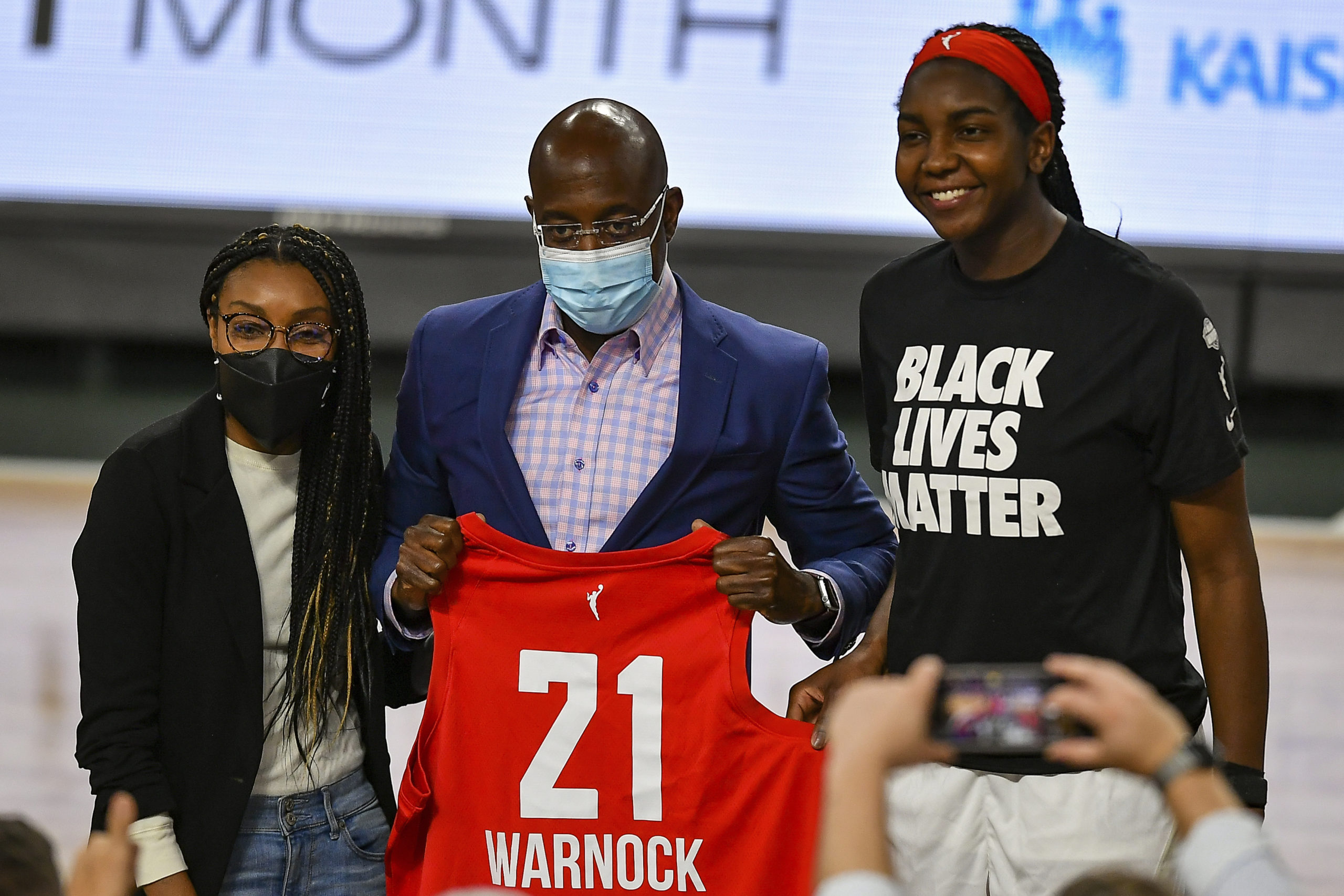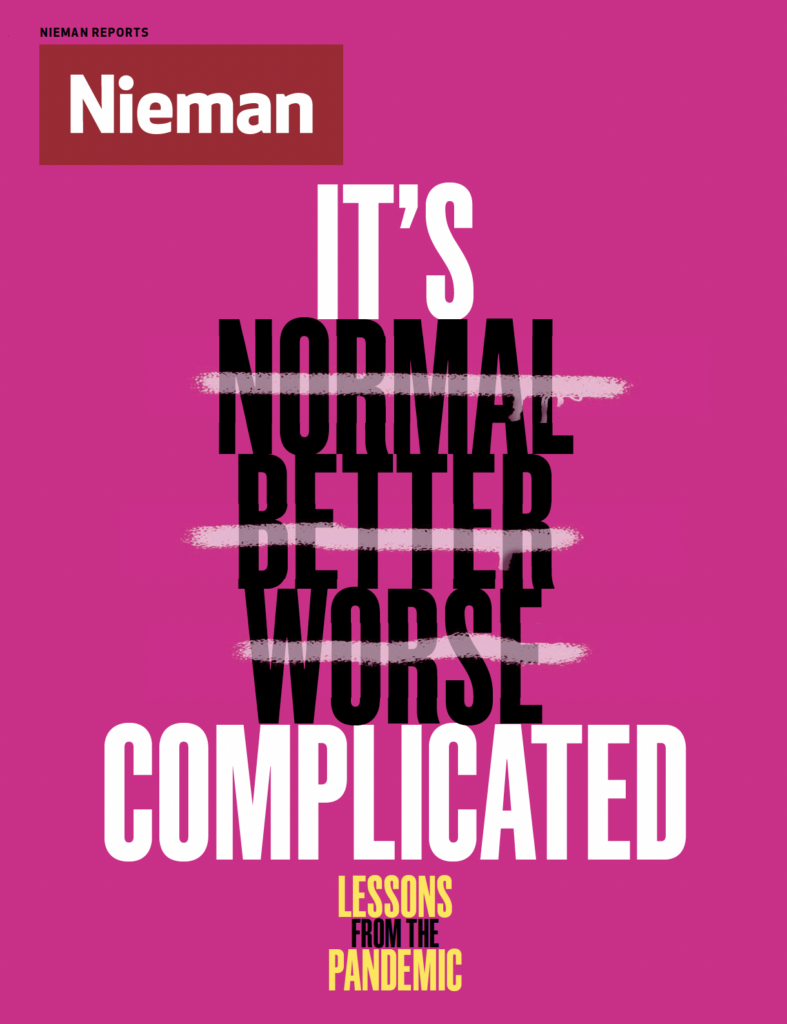At the time, Reverend Raphael Warnock was a little-known U.S. Senate candidate in Georgia, polling a distant third in the race. The incumbent, Kelly Loeffler, was a Republican who co-owned the WNBA’s Atlanta Dream and called Black Lives Matter a movement intent on promoting “violence and destruction across the county” in a letter to the WNBA commissioner. After the t-shirts debuted, Warnock’s poll numbers climbed right along with donations to his campaign. The WNBA and the t-shirts received widespread coverage, making national headlines everywhere from ESPN to The Washington Post to People Magazine.
A couple weeks later, I interviewed Los Angeles Sparks forward and WNBA Players Association president Nneka Ogwumike for a column. We talked about the “VOTE WARNOCK” t-shirts and the WNBA’s history of social activism. “Our movement has found its moment,” she said. The statement was prescient. In January, Warnock won his runoff election against Loeffler, becoming Georgia’s first Black senator and helping flip the U.S. Senate in the Democrats’ favor. The WNBA helped make that happen.
For many sports journalists, the pandemic expanded the beat beyond competition-focused coverage. It pushed reporters beyond play-by-play and day-to-day storylines. Of course, before March 2020, there were human interest features and hard news stories and hard-hitting investigations. There were storylines that put sports in a larger context and raised awareness. Colin Kaepernick kneeling to protest police violence. The U.S. women’s national soccer team fighting for equal pay. Olympic gymnasts speaking up about sexual abuse. Gay athletes coming out during their professional playing careers. But the coronavirus — and the murder of George Floyd at the hands of a Minneapolis police officer — brought a heightened sense of the many ways sports intersect and intertwine with the events shaping society. Sports reporters, by necessity, had to become politics, health, and culture reporters as well. That was what the moment demanded.
Part of the shift can be explained by fewer games to cover. I filled the early days of the pandemic with breathless reports of cancelations and postponements. The NBA came first in a furious burst of late-night and early-morning reporting, then the NHL and MLB, the NCAA basketball tournament, the Boston Marathon, the Tokyo Olympics, and much, much more. But when the sports world shut down and games stopped, it offered sports journalists an opportunity to step back and gain perspective, to reassess priorities, and ask bigger questions about the leagues, teams, and players they cover. That kind of inquiry doesn’t happen easily because of the non-stop nature of sports and the coverage it generates. See five NBA games scheduled for Christmas Day. There is always something to cover. And in my experience with outlets that churn out daily coverage, there is rarely the space or time to reflect on, to struggle with, the bigger sports and society-related issues and consider the best way to approach them.
On a more fundamental level, at a time when we were desperate for community, sports became an avenue for connection that went beyond the game, for entry into difficult conversations, for action, and for impact. The story quickly went from which team won to which players were protesting for social justice, from records set to which pro athletes were talking about mental health, an issue that took on greater significance as the pandemic wore on month after month. We covered mask policies, the controversy around vaccine mandates, COVID-19 protocols for college sports, and unemployment as thousands of industry workers were laid off because of upended seasons and empty arenas.
When we emerge from the pandemic, sports journalism needs to keep meeting the moment. It’s no longer enough to report on which players protest for social justice or which pro athletes talk about mental health, to react to the moments when sports collide with the big issues of the day. We need to explore what motivates athletes to act, to examine the power dynamics and systemic inequities at play, to think about what gets underreported and why, to investigate the gaps between the optics and the reality in sports. To accomplish that, newsrooms should consider focus areas that combine sports and social justice, sports and gender, sports and race, sports and health science. But more important than the kinds of cross-disciplinary coverage is the intent and commitment behind them.
Take, for example, USA Today Sports’ review of the political contributions of 183 team owners in the run up to the 2020 election. The paper found “nearly 86% of those funds [went] to Republican candidates and causes,” including political action committees aligned with Donald Trump. The article highlighted how owners publicly backed Black Lives Matter and the racial justice movement, but privately and financially supported candidates that railed against the movement. The story provides a good example of accountability journalism that connects the dots between sports, politics, power and race. There needs to be more of that.
Meanwhile, The 19th, which describes itself as an “independent, nonprofit newsroom reporting at the intersection of gender, politics and policy,” raised important questions with its stories timed around the Tokyo Olympics. One piece asked, “How have sexual assault protocols evolved at the Olympics?” and another wondered, “Will the Olympics ever truly welcome nonbinary athletes?” Another example is The New York Times’ piece on “the absence of a professional wheelchair league in the United States.” It was part of the paper’s Paralympic reporting, but it was also a reminder of the breadth of the sports world and the communities that deserve more regular coverage.
The sports landscape will undoubtedly change again in dramatic ways, and when that happens the sports media should make time to step back, to reexamine its priorities, and recalibrate to meet future moments. We need to continue to build that reflective, perspective-broadening muscle and exercise it regularly.
How do sports departments and sports journalists do that? How do they balance daily, incremental coverage with more time- and resource-intensive stories at the intersection of sports and society? That question concerned newsrooms pre-pandemic. Now, it’s even more critical as we plan for the next normal amid shrinking newsrooms. Even though big, well-staffed national outlets enjoy a natural advantage, the push-pull between incremental coverage and deeper dives remains an evergreen challenge for everyone.
One solution is to make sure that the sports department isn’t siloed off from the rest of the newsroom, diminished as the “toy department.” Collaborations inside newsrooms should be valued as much as collaborations between newsrooms. Also, it’s incumbent on sports journalists and sports outlets to see that the social and cultural significance of sports comes in many forms and many voices, especially as sports interest fragments into smaller and smaller niches. Yes, the games and all that surrounds them matter. But so do the stories that explore the intersection of sports and society, that dive into difficult subject matter and bring different perspectives to the forefront. Those stories make sports and sports coverage more meaningful and accessible. In the future, those stories should be seen as essential coverage, not some kind of special occasion journalism trotted out amid a pandemic or surge in social activism or moment of controversy.
Lessons from the Pandemic
Hope that the coronavirus is finally being brought under control has given rise to planning for a return to “normal.” But can, or should, journalism return to a pre-pandemic “normal?” Across newsrooms, the way we once covered education, labor, theater—any beat—is unlikely to be sufficient for the moment we are entering. What are the lasting lessons of this time, and how should we do journalism differently? These are the questions to which Nieman Reports is seeking answers in our essay series, Lessons from the Pandemic.




